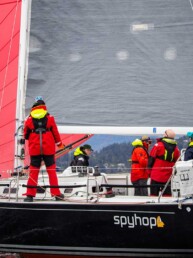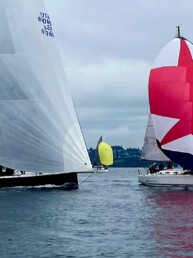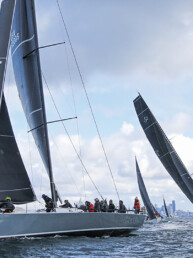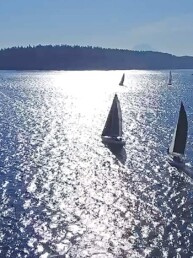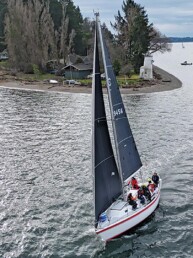
Remember the last America’s Cup and how thrilling it was to watch ORACLE TEAM USA snatch victory from Emirates Team New Zealand in the final down to the wire, winner takes all race in San Francisco Bay? Well that was over three years ago – how time flies, and so will the latest iteration of foiling wing sailed America’s Cup class boats.
Magically and majestically, the high performance AC50 catamarans can rise up on their foils and dagger boards giving the appearance of literally flying across the water and potentially reaching 50 knots of boat speed. Much has evolved since September 2013 but some things never change namely, the intense competition.
America’s Cup racing has always been at the cutting edge of naval design and the marine technological revolution. If you are a traditionalist you won’t like the look of the AC50s which are all about carbon fiber, hydraulic pressure and state of the art electronics. But, if you are looking for sailing that is fast, thrilling and athletic you will love the 35th America’s Cup challenge.
This time around the AC design protocol has a rule stating the hull design will be identical for each team. The idea is to keep overall costs for each campaign down and hopefully encourage more participants. There are five international teams who have signed on as Challengers: Emirates Team New Zealand, Land Rover BAR (UK), Artemis Racing (Sweden), Groupama Team France, SoftBank Team Japan.
Something of note, and pride, for us Pacific Northwest sailors is that the hull designer for the AC50 class is Paul Bieker, of Bieker Boats in Seattle. Many are familiar with his performance boat designs especially his Riptide 35.
Bieker has been with ORACLE TEAM USA since the beginning. His involvement dates from the early days of carbon fiber monohulls in the 2007 challenge and also with the successful 90 foot trimaran in 2010, both of which were built in Anacortes, Washington.
Bieker currently is Lead Design Engineer for the Oracle team. When interviewed, in typical Paul Bieker style, he modestly said: … “I keep my head down and try to make it as much of a group effort as possible. I’ve come to understand that is one of the strongest aspects of America’s Cup work – at its best it is a collaborative, teamwork based design project. That said, there are a few things I did myself – like the AC class hull shape.”
With identical hulls the critical features which each AC Team can modify are the foils, dagger boards, wing sail profiles and hydraulic systems. Incredibly the boats have the capacity to go 3 times the speed of the wind. One noticeable difference in this latest challenge is how much better the foiling potential is being exploited. Observers are going to be impressed with how crews can get the AC 50s to foil not only downwind but also upwind, stay up on foil through tacks and jibes and in light winds.
This does not mean the catamarans are easy to sail as evidenced in May when ORACLE TEAM USA capsized their boat while practicing start maneuvers. Fortunately no-one was hurt and the boat was quickly righted without sustaining any apparent damage. The capsize is a chilling reminder of the tragic death of Andrew (Bart) Simpson which occurred when the Artemis boat capsized in San Francisco Bay in May, 2013. The capsize is certainly evidence of how much confidence the Oracle team has in their boat and how far Helmsman Jimmy Spithill and his crew are willing to push the boat in pre-Cup race practice sessions.
Word from spies on the ground and on the Great Sound in Bermuda is that Artemis Racing appear to have great boat speed and have mastered the ability to stay up on foils better than the other teams. Nathan Outteridge skipper and helmsman has an impressive resume with International Moth Class World titles and a gold medal in the 49er class at the London Olympics to his credit. He is backed up by Iain Percy at Tactician and Team Manager another formidable talent in world class sailing.
Emirates Team New Zealand has come up with an innovative twist to the traditional muscle bound grinder with triceps the envy of Mr. Universe: they are using leg power, not arm power, to prime the hydraulic pressure systems that control the wings and the foils. Grinders will be mounted on bicycle-type pedestals in the hulls, leaving their hands free to manipulate sail trim controls on the handlebars. Whether this will improve boat speed is debatable – other teams say they rejected the concept as not being aerodynamic or practical. No captain wants sailors with cleats on board their boat!
Land Rover BAR gave an impressive showing in the Louis Vuitton AC45 World Series – the preliminary competition to the 35th Cup. Leading the fleet with an overall series score of 512 points ahead of Oracle who had 493 points and Team New Zealand with 485. The man of the hour is Sir Ben Ainslie who is heralded as a National hero throughout the British Isles. The phlegmatic Brits constantly gush over this 6 foot quiet unassuming sailor. Often described as the most successful sailor of our times – he won five gold medals in four consecutive Olympics – he is now Team Principal and Skipper of Land Rover BAR.
Come June, perhaps the “Auld Mug” will finally be going back to Jolly Olde England? If you’re a Brit, you certainly hope so. It’s been 166 years since the schooner America ‘stole’ the Cup away. Their (former) Commonwealth territories Australia and New Zealand have had more success in winning the Cup than the Brits themselves. This is a matter of national shame and the Brits are ready to vindicate themselves.
Also ready to vindicate himself is Dean Barker, Helmsman on SoftBank Team Japan. After losing the 34th AC in an excruciating last minute duel to the death he was ousted from Emirates Team New Zealand. Now he is back for his 6th America’s Cup Challenge this time with SoftBankTeam Japan who have put their trust in him to make history by being the first Japanese Team to win the Cup. This might seem like a long shot but the SoftBank Team have their team compound in Bermuda right next to the Oracle Team Base. For the past two years Dean Barker has been racing alongside his nemesis, Jimmy Spithill, which may give him a strategic and psychological advantage come race day.
Long shot outsider Groupama Team France is led by Helmsman Franck Cammas. The team did not fare well in the AC World Series plus they had a major setback when Cammas fell off a GC 32 catamaran and was hit by the rudder causing serious injury to his leg. The accident and subsequent surgery sidelined him for several months but in Spring 2016 he was back on the boat with no apparent permanent damage. Whether they can make up for lost time remains to be seen but remember the French have long been worldwide pioneers of catamaran sailing.
The preliminary racing for the Cup Qualifiers and the Challenger Playoffs began in Bermuda on May 26 as a series of round robin races.
So, the question on many lips is “how come it’s in Bermuda?”
The venue this time around will be very different from the cold grey waters of San Francisco Bay with a backdrop of the Golden Gate Bridge and Alcatraz. Bermuda has a fringe barrier reef to break the Atlantic surf and the Great Sound is blessed with warm clear turquoise water. Pastel painted colonial houses are sprinkled along the shores of the lush archipelago made up of 181 islands.
The total area of Bermuda is 20.54 square miles, which is larger than Mercer Island but smaller than Vashon Island, with a population of nearly 65,000. The atmosphere is laid back, everyone is friendly and the culture is one of civility and politeness. Children in their school uniforms ride the public buses to school saying, ‘Good morning’ to other passengers and ‘Thank you Mr. Bus Driver’ as they get off.
Many thought the Bay Area was the perfect venue, but apparently the San Francisco City Fathers did not want to play ball. A more enticing package to host the Cup was offered by the Bermudian Government. The British Overseas Territory suffered a severe economic decline during the Great Recession and they saw this as an opportunity to showcase their country and re-boot the economy.
As a commitment to the Cup Bermuda promised to complete a huge land reclamation project in the Great Sound. Cross Island, which is located next to the Royal Docklands, will house the teams and the America’s Cup Event Village during the competition. Once the Cup is over it will become part of the Cruise Terminal allowing larger cruise ships to visit Bermuda.
Bermuda is located 600 miles east of the North Carolina coast which makes it more easily accessible to Europe than the US west coast. Plus, the time zone difference allows for prime real time media broadcasting in Europe, a marketing advantage to the team and event sponsors.
However, as the date for racing draws closer, a major concern is whether this small island nation can accommodate the number of visitors who want to see the America’s Cup in person. The influx of tourists threatens to overwhelm the infrastructure.
By now, Cup fans will be able to watch all six boats competing on the water. The path to the 35th America’s Cup is exceptionally complicated but should make for lots of close racing and intense on the water entertainment.
In an unprecedented move ORACLE TEAM USA will actually participate in the first round of qualifying races. At the end of that qualifying round, the top four Challengers move on to the Playoff series. The Challengers will divide into two semifinals after which the winners will face off in a Challenger final. The Louis Vuitton America’s Cup Challenger Playoffs will continue until June 12. Each playoff round is a first to five series. The winning boat becomes the official Challenger of record and will have earned the privilege of going up against the Defending Champion ORACLE TEAM USA in the 35th America’s Cup Match.
The first race between the Challenger and the Defender will take place on June 17. The Match format will be a best out of seven series, with the option of going to 13 races should it be necessary.
Who knows if the 35th America’s Cup will be as much a nail biter as the 34th Cup but, on the day, much will come down to how efficiently each crew can sail their boat … and that is how it has always been in sailboat racing. For more information on the America’s Cup competition, teams and schedule of events go to: http://americascup.com/
By Wendy Gray
Photo by Mac Madenwald
Joe Cline
Joe Cline has been the Managing Editor of 48° North since 2014. From his career to his volunteer leadership in the marine industry, from racing sailboats large and small to his discovery of Pacific Northwest cruising —Joe is as sail-smitten as they come. Joe and his wife, Kaylin, welcomed a baby girl to their family in December 2021, and he is enjoying fatherhood while still finding time to sail, make music, and tip back a tasty IPA every now and again.

